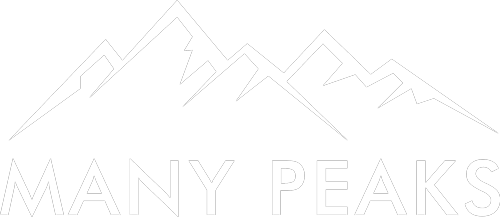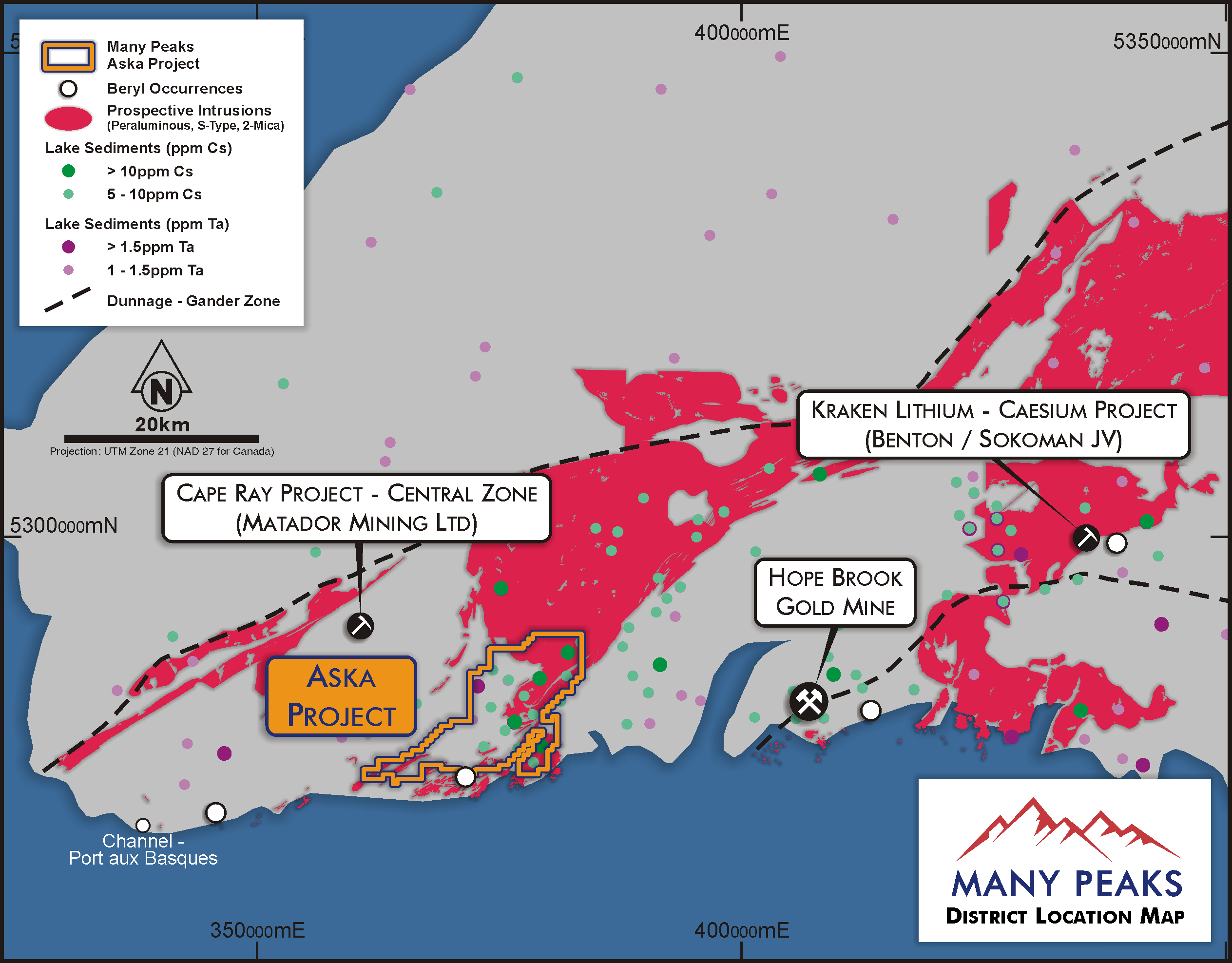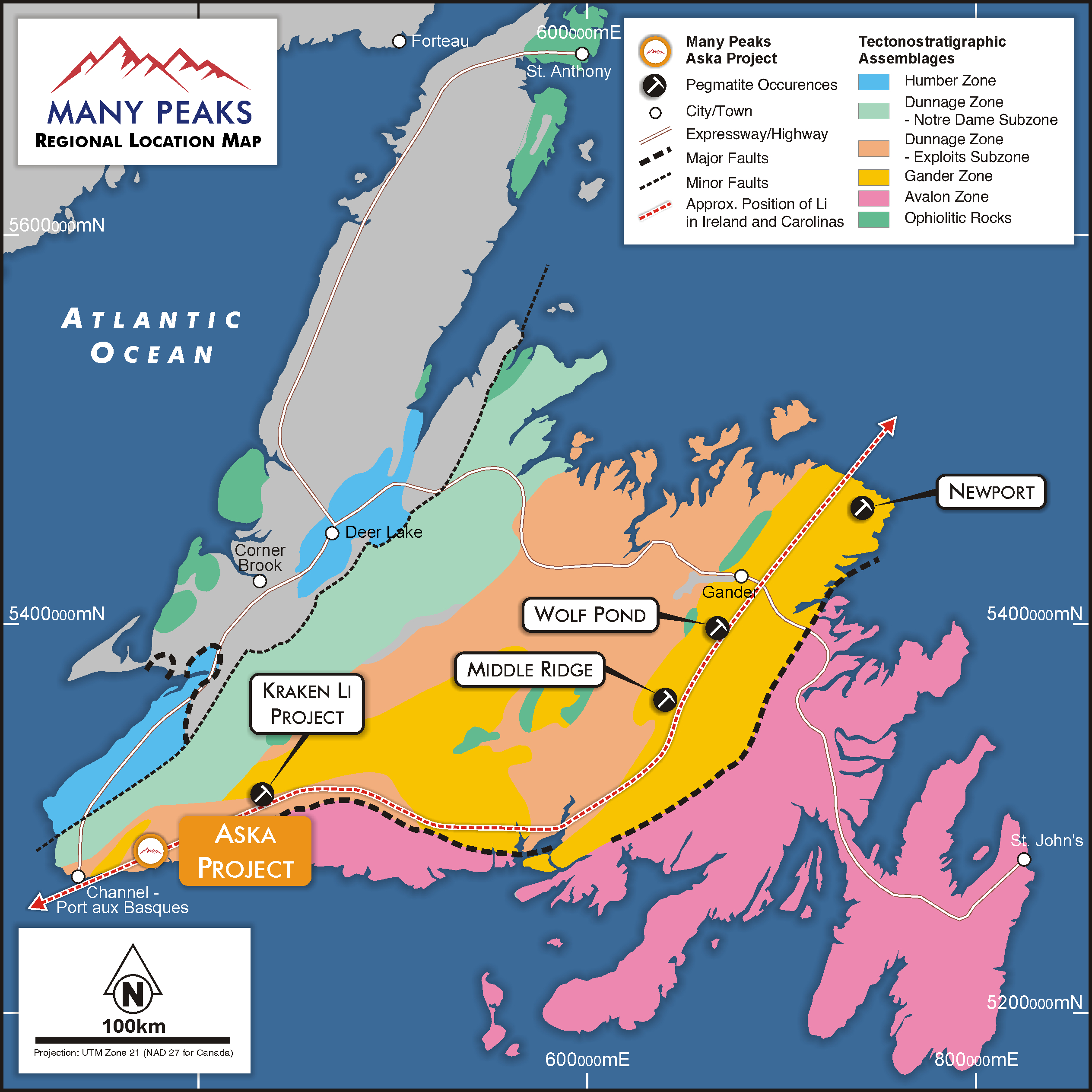Aska Lithium Project
Located in the Labrador and Newfoundland province in eastern Canada the Aska Lithium Project (Aska) is located proximal to Newfoundland’s southwest coast approximately 45km east of Cape Ray.
Aska is situated within the same belt of intrusions as hosts the Avalon lithium deposit in Ireland and the Piedmont and Kings Mountain lithium deposits in the eastern United States.
Highlights
- Host to an extensive pegmatite field on trend with multiple known beryllium and lithium occurrences
- 193km2 contiguous land position within terrane hosting Lithium-caesium-tantalum (LCT) type pegmatite occurrences
- Lake sediment sampling results highlight caesium and tantalum anomalism in the Aska Pegmatite field – bracketed by several Beryllium and lithium occurrences along the Gander-Dunnage zone
- Multiple pegmatites confirmed in reconnaissance mapping, hosted in S-Type granites and extending into adjacent metamorphic host rocks associated with Caesium and Tantalum anomalism in regional scale datasets
- Further exploration planned to define metallogenic zonation to the pegmatite field and advance targeting of a ‘goldilocks zone’ hosting spodumene mineralisation in zonation with other diagnostic minerals for LCT pegmatites
Geologic Setting
Newfoundland hosts a segment of a major tectonic collision zone that forms an integral part of Newfoundland’s Gander-Dunage zone. That zone, along with its extensions into Ireland and the Carolinas formed an integral part of the Gondwanan supercontinent and was situated in a major tectonic collision zone which formed multiple granite intrusions of similar composition at the margins of the Avalonia subcontinent. With the opening of the Atlantic Ocean Avalonia was fragmented and is located across present day South and North Carolina, Nova Scotia and Newfoundland on west side of the Atlantic. On the east side of the Ocean the same terrane can be traced from Europe through Ireland and the south Cornwall nappes.
The Newfoundland segment of this tectonic terrane is an underexplored portion of this well-endowed corridor of intrusions and pegmatites.
Aska is host to an extensive pegmatite field situated within a tectonic terrane that is host to multiple lithium oxide deposits. Lake sediment sampling results compiled by the Newfoundland and Labrador Geological survey highlight caesium and tantalum anomalism in the Aska Pegmatite field.
The age of intrusions occurring at the Aska Project in Newfoundland are of Devonian age [reported as forming between 385 million years ago (Ma) and 420Ma] is the similar age of intrusions associated with major lithium deposits in the same terrane, including the world class Carolina Tin-Spodumene Belt (hosting the Piedmont Lithium Project and previously mined Kings Mountain deposit) and the Avalonia Project in Ireland being explored by Ganfeng Lithium Corp’s subsidiary GFL International Co. Ltd.
The Gander-Dunage zone in Newfoundland and the extensions of that terrane into Ireland and the Carolinas formed an integral part of the Gondwanan supercontinent and was situated in a major tectonic collision zone which formed multiple granite intrusions of similar composition at the margins of the Avalonia subcontinent. With the opening of the Atlantic Ocean Avalonia was fragmented and is located across present day South and North Carolina, Nova Scotia and Newfoundland on west side of the Atlantic. On the east side of the Ocean the same terrane can be traced from Europe through Ireland and the south Cornwall nappes.
Mineralisation
The Aska Project is host to a geologic setting within a larger belt of intrusions prospective for Lithium-caesium-tantalum (LCT) pegmatites, which comprise a compositionally defined subset of granitic pegmatites. LCT pegmatites often form as products of plate convergence during collisional orogeny. Typically controlled by pre-existing structures, LCT pegmatites typically occur near evolved, peraluminous granites and leucogranites and hosted in supracrustal rocks in the upper greenschist to lower amphibolite facies of metamorphism. Critical commodities mined from LCT-bearing pegmatite-fields include Be, Nb, Ta, Sn and Li.
Within the Gander-Dunnage zone in Newfoundland, pegmatite related mineralisation is extensive with mapped beryl occurrences in pegmatites located throughout the Gander-Dunnage zone and immediately south and southwest of the Aska project area, however with no previous exploration for lithium mineralisation in the district.
Recognition of the lithium potential in Newfoundland is in its early stages and is currently being explored for in the district by multiple Canadian listed explorers, and exploration activity includes continued work on the recent discovery of spodumene mineralisation and high grade Ceasium mineralisation at the the Kraken pegmatite district located approximately 60km east Aska.







